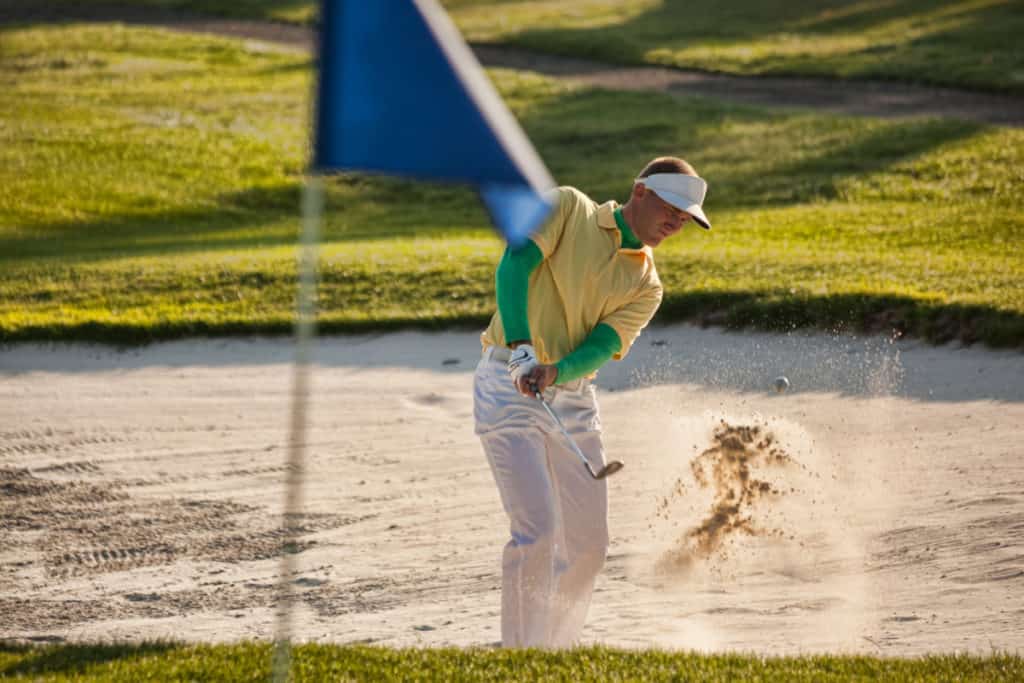What is an Up and Down in Golf? It’s Important to Know!

Golf beginners quickly find they not only have to learn the complexities of the golf swing but also what at first likely appears to be a foreign language.
The game involves the use of a number of unique expressions and terms and one of the most important ones new players will learn is the ‘up and down’.
So what is an ‘up and down’ in golf? To get ‘up and down’ in golf requires a player to put the ball into the hole in 2 strokes or less from anywhere their ball is resting around the green. The first stroke, a ‘chip’ or ‘bunker’ shot, will get the ball ‘up’ onto the green and the following putt will put the ball ‘down’ into the hole.
As with a lot of things in golf though, once you learn one term you will find there are another 2 or 3 similar ones which come up in conversation.
And the term ‘up and down’ is no exception.
‘Up and down’ and friends – ‘Sand Saves’ and ‘Scrambling’
An ‘up and down’ measures a player’s ability to get the ball into the hole in 2 strokes from around the green. ‘Around the green’ is however not a defined term itself but practically means anywhere within 30 yards of the hole.
So if your ball lands anywhere within 30 yards of the hole, but not on the green, and you subsequently get the ball into the hole in 2 strokes or less you will be said to have got ‘up and down’.
This is slightly different to ‘scrambling’ which has a set definition.
The Professional Golfers Association (PGA) European Tour and the PGA of America – the two main professional golfing tours in the World – define ‘scrambling’ as follows:
“The percentage (%) of time a player misses the ‘Green in Regulation’ (GIR) but still scores par or better”
See what we mean by one golf term linking straight away to 2 or 3 others! Hitting a ‘’Green in regulation’ (GIR) means that a player has taken two or fewer strokes than the scoring par for the hole to put any part of their ball on to the green – for example they hit the green in 1 stroke on a par 3, in 2 strokes or less on a par 4 and in 3 strokes or less on a par 5.
Source: PGA of America
So, a player can get an ‘up and down’ but it might not necessarily have been a ‘scrambling’ up and down.
An ‘up and down’ itself does not have the requirement that the player has to make par or better which ‘scrambling’ does.
‘Sand saves’ are another specific type of ‘up and down’.
This is defined as follows by the European and PGA Tours:
“The percentage (%) of time a player was able to get ‘up and down’ once in a greenside bunker (regardless of the score).

Therefore, and unlike scrambling, a ‘sand save’ does not have the requirement that the player has to score par or better.
The requirement in this instance is that the ‘up’ shot must have been from a bunker.
Here are a few practical examples to help:
- A player is playing a par 3 hole and misses the green with their first shot and the ball comes to rest yards away from the green. They then chip ‘up’ onto the green and hole or ‘down’ the following putt to score 3. This is both a successful ‘up and down’ and a successful ‘scramble’.
- The player then plays a par 4 hole and after four bad shots is still not on the green and 20 yards away. The player pitches onto the green and again manages to hole their putt. This is a successful ‘up and down’ but would not be considered a scramble as they did not score par or better.
- At the next hole, a par 5 the player takes five shots to reach a bunker beside the green. They then play a good bunker shot and manage to sink the putt. This is both a successful ‘up and down’ and ‘sand save’. Again it would not be considered a scramble as their score was 7, two over the par of 5.
- Their playing partner meanwhile, at the same par 5, is still 150 yards away from the green after taking 3 shots. They then hit a fantastic shot to around 10 feet from the hole and successfully hole their putt. This would be considered a successful ‘scramble’ but not an ‘up and down’ as their shot which made it to the green was well over 30 yards and therefore was not from ‘around the green’.
Having a number of different terms for much the same thing may seem odd but the reason for it can be seen in what statistics different standards of players measure to try and improve their game.
For professional golfers for example ‘scrambling’ is a more important statistic for them as they can and want to make par or better on every hole.
Amateur players, by comparison, will typically be scoring much higher – the average 10-19 handicapped golfer makes a par only 25% of the time and that number drops to 13% for players of 20+ handicap – and so the broader statistic of an ‘up and down’ is more relevant to measure for their game.
Why is an ‘up and down’ so important in golf?
In golf every shot counts without exception.
But as you get closer to the hole the opportunity to recover from a poor shot continues to reduce so the shorter the shot you have the more important it gets.
For example, if you hit a poor drive, you will have a number of opportunities afterwards to hit a shot which can recover the hole for you.
Similarly, if you hit a bad long shot you will likely have another couple of opportunities, either with a good chip shot or putt, to make up for it.
But the impact of a poor short game is more critical simply because there are less chances to make up it.
After a poor chip you will probably only have one more chance with your next putt to make amends.
Hit a poor putt and your chances of recovering are the lowest of all the shots you will play.
So by the fact an ‘up and down’ involves the shortest shots in the game – chips and putts – it is clear how critical a good short game is.
The statistics back this up too.
As we can see from the table below there is a huge gap between the average ‘up and down’ skills of the lower and higher handicapped players.
| PLAYER | UP AND DOWN | SCRAMBLING | SAND SAVES |
| Best professional | 85% | 68% | 66% |
| Scratch (0) | 77% | 52% | 51% |
| 10 handicap | 46% | 32% | 7% |
| 20 handicap | 17% | 21% | 1% |
| Sources: 2/01, 8/08 Golf Digest, PGA Tour |
So the message is clear. The short shots involved in getting ‘up and down’ are critically important and the better you are at them the more your scores will improve.
How can I get better at getting up and down
Many beginner golfers will get increasingly frustrated as they get closer to the green as the expectation simply because the expectation that shorter shots must be easier is not always matched by reality.
More often than not though a poor strategy and bad implementation of that strategy is to blame for a player’s poor short game.
It is therefore important that players do 3 things to improve how often they get ‘up and down’:
- Set clear goals for the initial chip shot
- Keep things simple by using one ‘short’ swing for all short shots, and
- Keep a record of your progress,
Dave Pelz, the famous American short game teacher, points out that short game shots have 2 distinct parts:
- How far they fly in the air, and
- How far they move after they hit the ground.
It makes sense therefore that every golfer should have a clear goal for each part of their chip shot before they play it.
So make sure you set a ‘landing target’ for each pitch – Pelz recommends a 3 foot diameter circle – and also a ‘final target’ for the ball, for example 3 feet from the hole.
Having clear targets is only the first step however.
Next, beginner and high handicap golfers should develop a strategy to keep their chip shots as simple as possible and so give themselves the most margin for error.
A typical high handicapped player will usually automatically reach for their most lofted club for every chip shot and try and land the ball right next to the hole.
That however requires a longer backswing and more feel and timing, which most amateur golfers struggle with.
Dave Myers, a Staff Instructor at the Tour Academy in TPC Sawgrass, Florida recommends keeping things much simpler.
He says players should have ONE ‘go-to’ shot around the green which they can play with a variety of clubs and which keeps the swing as short as possible.
The shorter the swing, the easier it is to make solid contact with the center of the clubface, and control your distance.
By then targeting a ‘landing area’ at the front the green, and using different lofted clubs to control the carry distance to that landing area and how far the ball then rolls to the ‘final target’, golfers will build more consistency to their short game and record more ‘up and downs’.
The final way to help improve how often you get up and down is simply to keep a track of how well you do each time.
Simply record how often you have a chip shot, how often you hit your ‘landing’ and ‘final’ target and finally how often you get up and down.
You will soon see what aspect of your short game needs to improve and how you can boost that all-important ‘up and down’ statistic!
More great articles related to this topic
- How Far Should You Hit Your Wedges? Be Sure to Fill the Gaps!
- Good Putting Numbers – It’s About 3 Putts Not Putts per Round
- Going the Distance? How Far Should Beginners Hit A Golf Ball?
Related questions
What is the best shot in golf called? The best shot in golf is unofficially named a ‘condor’. It might also be called a ‘triple eagle’. It is an extremely rare, almost impossible, score on an individual hole of 4 under par. As of 2012 only four accepted condors had been recorded all involving a hole in one on a par 5 hole.
Why does golf use bird terms? Birdie, a score of 1 under par on a hole, came from an American slang term ‘bird’ meaning excellent. ‘Eagle’, a score of 2 under, also started with USA golfers thinking of their national symbol as extending the excellence theme. Albatross, a score of 3 under, by comparison was first used in Britain.
RECENT ARTICLES
LEGAL INFORMATION
This site is owned and operated by Golfing Focus Limited, a private limited company whose registered office is in London, UK. Golfing Focus Limited is a participant in the Amazon Services LLC Associates Program, an affiliate advertising program designed to provide a means for sites to earn advertising fees (at no cost to you) by linking to Amazon.com. Golfing Focus Limited also participates in other affiliate programs with the eBay Partner Network, FlexOffers, CJ.com, Svorn and other sites and is compensated for referring traffic and business to these companies (again at no cost to you).
Our Socials






Leave a Reply